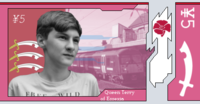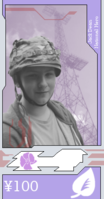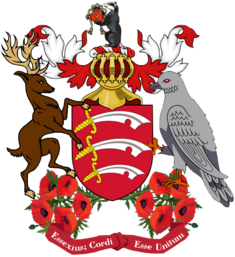Essexian Yen
This article needs to be updated. |
| Essexian Yen | |||||
|---|---|---|---|---|---|
| |||||
| ISO 4217 | |||||
| Code | EXY | ||||
| Denominations | |||||
| Plural | Essexian Yen | ||||
| Symbol | ¥ | ||||
| Banknotes | ¥5, ¥10, ¥20, ¥50, ¥100 | ||||
| Coins | ¥1, ¥2 | ||||
| Demographics | |||||
| User(s) | temporarily | ||||
| Issuance | |||||
| Central bank | Imperial Bank of Essexia | ||||
| Valuation | |||||
| Pegged with | British Pound Sterling | ||||
The Essexian Yen (Symbol: ¥) is the official currency of the Commonwealth of Essexia, and is managed, distributed, and printed by the Imperial Bank of Essexia.
It was founded around June 2018, when Earl Jack created the first notes in Adobe Photoshop and sent them to the Essexia discord. They were plain, and featured an anti-forgery-edited image of Emperor Terry, next to a coloured hexagon, which in turn was in front of the English flag. These notes were colour coded to depict the amount. They were later replaced by Earl Finn's more detailed, realistic, and redesigned notes, which are based off of the Royal Bank of Scotland polymer notes, these notes were known as the Jupiter Series. The Jupiter Series notes featured a notable person in the history of Essex on the front: Guglielmo Marconi (Father of Radio, which was first built in Chelmsford, Essex) on ¥5, Alan Davies (comedian) on ¥10, Sadia Azmat (comedian) on ¥20, Edward Bell (Major General) on ¥50, and Arthur Fanshawe (Civil Servant) on ¥100), and Emperor Terry on the reverse. Each note is colour coded depending on the amount depicted, and are horizontal. They also feature a transparent window, as well as several anti-forgery designs.
During the Danbury Conference, Earl Finn unveiled the Orion Series of Essexian Yen to replace the Jupiter Series. Both series will be accepted within Essexia until 14 January 2020.
Special edition notes
To celebrate certain occasions or individuals within Essexia, sometimes special edition vertical notes are designed and printed. These are identical to the standard horizontal notes, however the people depicted and the backgrounds are rotated 90 degrees. They keep the same colour code as the amount they represent (e.g. ¥5=red/pink, 10=blue, ¥20=green, ¥50=gold, ¥100=purple).
-
¥5 note, front -
¥5 note, reverse -
Special edition ¥100 vertical note, front -
Special edition ¥100 vertical note, reverse






